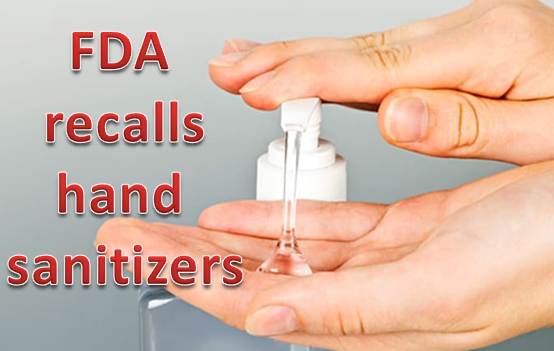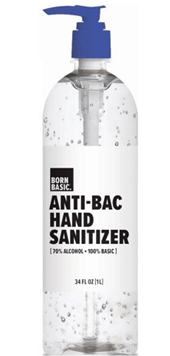FDA recalls 150 brands of hand sanitizers: How can consumers keep track?
 With the need to clean hands frequently during the COVID-19 pandemic, hand sanitizers became a hot commodity on the go. The familiar brands such as Purell immediately disappeared from the shelves. Consumers needed to resort to buying unfamiliar brands of hand sanitizers. However, we all quickly discovered that many of the hand sanitizers contained poisonous, undeclared compounds.
With the need to clean hands frequently during the COVID-19 pandemic, hand sanitizers became a hot commodity on the go. The familiar brands such as Purell immediately disappeared from the shelves. Consumers needed to resort to buying unfamiliar brands of hand sanitizers. However, we all quickly discovered that many of the hand sanitizers contained poisonous, undeclared compounds.
For hand sanitizers, the CDC recommends using alcohol-based products containing at least 60% ethyl alcohol (ethanol) or 70% isopropyl alcohol (isopropanol).
Early on during the public health COVID-19 emergency, as demand for alcohol-based hand sanitizer had dramatically increased, the FDA issued temporary policies to provide flexibility to meet this demand and help get supplies quickly to where it was needed. The guidelines were updated in April, indicating that at least some of the ethanol-based products had harmful chemicals, including gasoline and benzene, known as human carcinogens.
Two months ago, the FDA began recalling hand sanitizers because certain products contained methanol, also known as wood alcohol, and more recently, 1-propanol. In the past couple of months, 150 hand sanitizers have been recalled by the FDA.
Why methanol should not be used in hand sanitizers
In June, the FDA started warning consumers and healthcare workers not to use hand sanitizers containing methanol, which is often used to produce fuel and antifreeze that can be toxic to humans when absorbed through the skin. The product containing methanol could result in nausea, vomiting, headache, blurred vision, permanent blindness, seizures, coma, and permanent damage to the nervous system or even death.
Survivors of methanol poisoning might have a permanent visual impairment, including complete vision loss. While methanol can be absorbed through the skin, it is rare to get methanol poisoning that way. The most danger arises by drinking the product.
Why 1-propanol should not be used
More recently, the FDA started warning consumers and health care professionals about hand sanitizer products labeled to contain only ethanol or isopropyl alcohol, but that have tested as containing 1-propanol contamination.
1-propanol (not to be confused with 2-propanol/isopropanol/isopropyl alcohol) can be toxic and life-threatening when ingested. It is most dangerous to young children, who might accidentally swallow the product and adolescents and adults that might drink it as an alcohol substitute.
Swallowing 1-propanol can lead to central nervous system depression, which can be deadly. Signs of 1-propanol exposure include confusion, decreased consciousness, and slowed pulse and breathing. Applying 1-propanol to the skin or eyes can irritate, and there have been rare instances of allergic skin reactions.
The FDA actions

The FDA continues to add more hand sanitizers to their recall list almost daily. Most products are entering illegally from Mexico, and the FDA has issued warning letters to companies that violated federal law. The problem with these recalls is that consumers and retailers have a hard time following the recalled brands.
I had the personal experience of buying a hand sanitizer at Target. Several weeks later, we discovered that the FDA recalled the product as containing methanol. We could have used the full product by then, but lucky us, we did not yet start using it. When we returned it to the store, the person at the return counter was unaware of the recall and was surprised to see the FDA notice that I printed.
Most products on the FDA banned list are labeled as “Made in Mexico,” according to the FDA. The products were sold in major outlets such as Walmart, Costco, Target, and BJ’s Wholesale Club.
CDC reports: Serious Adverse Health Events, Including Death, Associated with Ingesting Alcohol-Based Hand Sanitizers Containing Methanol
The CDC reported that from May 1- June 30, 2020, 15 cases of methanol poisoning were reported in Arizona and New Mexico, associated with ingested alcohol-based hand sanitizers. All were admitted to a hospital. Four patients died, and three were discharged with visual impairment.
Six patients developed seizures while in the hospital, and three were discharged with new visual impairments, the researchers found. According to the CDC paper, one patient (44-year-old man), said that he drank hand sanitizer in the few days before seeking medical care. The patient was hospitalized for six days for acute methanol poisoning, and when he was discharged, he went home with almost complete vision loss.
There must be a better way to notify the public
It is currently challenging for consumers to identify legitimate hand sanitizers and separate them from harmful products. More recently the FDA is warning that some brands may not be strong enough level of alcohol to kill the bacteria or COVID-19. Worse, some of those sanitizers also contain methanol.
The ever-growing FDA list has difficulty keeping up with the situation in the marketplace. There must be a better way to remove the defective hand sanitizers promptly. Why not test them at the border and not allow the faulty products to pass the border. In addition, the FDA could pre-approve safe products indicating them clearly on the front labels.

One response to “FDA recalls 150 brands of hand sanitizers: How can consumers keep track?”
The FDA is warning that some hand sanitizers that are being packaged in containers that may appear as food or drinks (beer cans, children’s food pouches, water bottles, juice bottles, and vodka bottles) and may put consumers at risk of serious injury or death if ingested. Additionally, the FDA has found hand sanitizers that contain food flavors, such as chocolate or raspberry. Drinking only a small amount of hand sanitizer is potentially lethal to a young child.